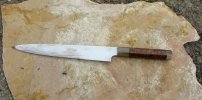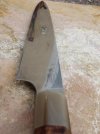hello everone
I am thinking about try my hand t making a few Japanese style kitchen knives i make mostly hunting knives and camp knives. so i don't usually make anything thinner then an 1/8th. i was wondering if any of you have any advice forging and heat treating these thinner blades. Thanks for the help guys
I am thinking about try my hand t making a few Japanese style kitchen knives i make mostly hunting knives and camp knives. so i don't usually make anything thinner then an 1/8th. i was wondering if any of you have any advice forging and heat treating these thinner blades. Thanks for the help guys







